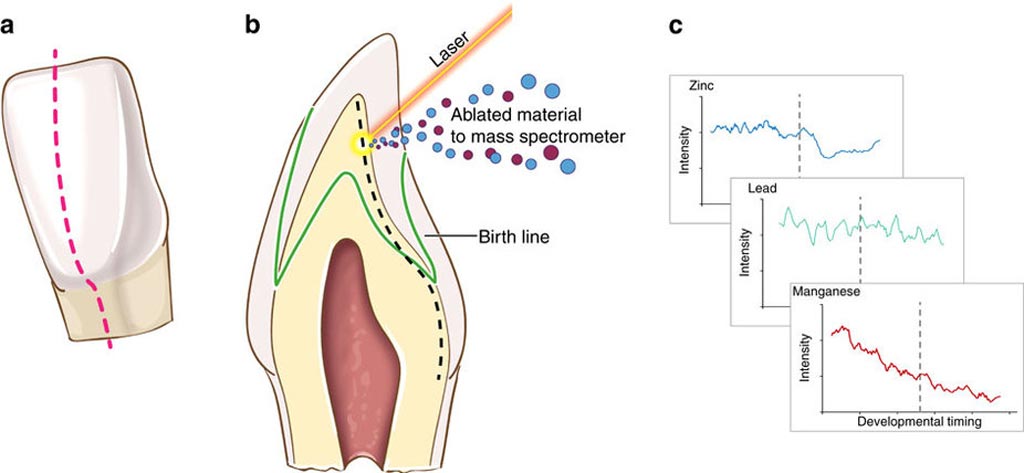Baby Teeth Reveal Association Between Autism and Metals
By LabMedica International staff writers
Posted on 12 Jun 2017
Analyzing fetal and postnatal teeth, researchers have found that levels of specific metal nutrients and toxins during pregnancy and early childhood is correlated with risk of developing autism spectrum disorders (ASD). Both amount and timing of abnormal levels can affect risk and diagnosis.Posted on 12 Jun 2017
The work was performed collaboratively by researchers from the Icahn School of Medicine at Mount Sinai Health Center (New York, NY, USA) and the Karolinska Institute (Solna, Sweden). The principal investigator at Karolinska Institute, Prof. Sven Bölte, PhD, leads the related Roots of Autism and ADHD Twin Study Sweden (RATSS).

Image: An overview of tooth-matrix biomarkers applied in this study (Photo courtesy of Arora M et al / Nature Communications).
Their study revealed that differences in uptake of multiple toxic and essential elements over the second and third trimesters and early postnatal periods are associated with the risk of developing ASD. The critical developmental windows for the observed discrepancies varied for each element, suggesting that systemic dysregulation of environmental pollutants and dietary elements may serve an important role. They also pinpointed developmental time periods when elemental dysregulation poses the biggest risk for autism later in life.
“We found significant divergences in metal uptake between ASD-affected children and their healthy siblings, but only during discrete developmental periods,” said Manish Arora, PhD, BDS, MPH, director of Exposure Biology at Mount Sinai, “Specifically, the siblings with ASD had higher uptake of the neurotoxin lead, and reduced uptake of the essential elements manganese and zinc, during late pregnancy and the first few months after birth, as evidenced through analysis of their baby teeth. Furthermore, metal levels at 3 months after birth were shown to be predictive of the severity of ASD 8-10 years later in life.”
The exact causes of ASD are unknown, but both environmental and genetic causes are likely involved. Specific environmental factors and stages of life when such exposures may have the biggest impact are poorly understood. Previous research indicates that fetal and early childhood exposure to toxic metals and deficiencies of nutritional elements are linked with several adverse developmental outcomes, including intellectual disability and language, attention, and behavioral problems.
To help determine effects that the timing, amount, and subsequent absorption of toxins and nutrients have on ASD, the researchers used validated tooth-matrix biomarkers to analyze baby teeth collected from pairs of identical and non-identical twins, of which at least one had a diagnosis of ASD. They also analyzed teeth from pairs of normally developing twins that served as the study control group.
During fetal and childhood development, a new tooth layer is formed every week or so, leaving an “imprint” of the micro chemical composition from each unique layer, which provides a chronological record of exposure. The team used lasers to reconstruct these past exposures along incremental markings, similar to using growth rings on a tree to determine the tree’s growth history.
“Our data shows a potential pathway for interplay between genes and the environment,” said Abraham Reichenberg, PhD, professor at Mount Sinai, “Our findings underscore the importance of a collaborative effort between geneticists and environmental researchers for future investigations into the relationship between metal exposure and ASD to help us uncover the root causes of autism, and support the development of effective interventions and therapies.”
Additional studies are needed to determine whether the discrepancies are due to differences in how much a fetus or child is exposed or because of a genetic difference in how a child takes in, processes, and/or breaks down these metals and nutrients.
The Seaver Center for Autism Research and Treatment at Mount Sinai is recruiting twins or siblings for further study. For information about participating, email theseavercenter@mssm.edu.
The study, by Arora M et al, was published June 1, 2017, in the journal Nature Communications.
Related Links:
Mount Sinai Health Center
Karolinska Institute













